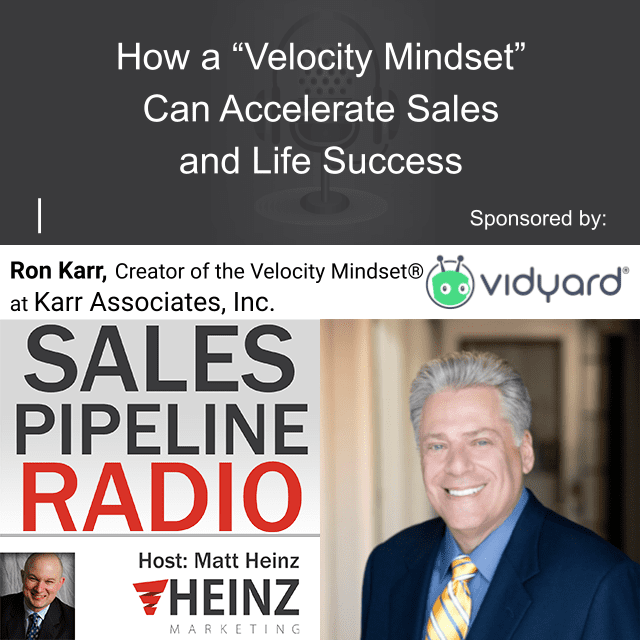Sales Pipeline Radio, Episode 255: Q & A with Ron Karr @ronkarr

By Matt Heinz, President of Heinz Marketing
If you’re not already subscribed to Sales Pipeline Radio, or listening live every Thursday at 11:30 a.m Pacific on LinkedIn (also on demand) you can find the transcription and recording here on the blog every Monday morning. The show is less than 30 minutes, fast-paced and full of actionable advice, best practices and more for B2B sales & marketing professionals.
We cover a wide range of topics, with a focus on sales development and inside sales priorities. You can subscribe right at Sales Pipeline Radio and/or listen to full recordings of past shows everywhere you listen to podcasts! Spotify, iTunes, Blubrry, Google Play, iHeartRADIO, Stitcher and now on Amazon music. You can even ask Alexa!
This week’s show is called “How a “Velocity Mindset” Can Accelerate Sales and Life Success” and our guest is Ron Karr, Keynote Speaker/CEO Best Selling Author | Creator of the Velocity Mindset® at Karr Associates, Inc.
Join us as we discuss how Ron came to write his new book, The Velocity Mindset, the true definition of velocity and being purpose driven, the art of the pause, best practices for listening to your market, and more.
Listen in now for great insights and/or read the full transcript below or watch the video here.
Matt: Well, welcome everyone to another episode of Sales Pipeline Radio. I’m your host, Matt Heinz, and I am excited to be here, excited to have you here. If you are watching this live on LinkedIn, Facebook, or YouTube, thank you very much for joining us in the middle of your workday. Really excited to have you here. If you’re watching this on demand on LinkedIn or listening to the audio version through our podcast feed, thank you so much for subscribing and downloading. You can find us on LinkedIn live every Thursday at 11:30 Pacific, 2:30 Eastern. And every episode of Sales Pipeline Radio, all 300ish episodes are available on demand at salespipelineradio.com.
We are featuring some of the best and brightest minds in B2B sales and marketing each week, bringing their ideas, insights, and competitive advantages to you. Also very excited to welcome our sponsor Vidyard, a fairly new sponsor as we continue to grow the podcast and the audience, excited to welcome some companies that we not only think are doing great work with great products, but doing it well and doing it the right way. So I’ll talk a little more about Vidyard a little later, including some materials they’ve got for us, including a virtual sales video conversion kit. But we want to get right into it with our guests today. Very excited to have with us, Ron Karr. He is a leadership coach, consultant, author, and the author of the new book The Velocity Mindset. So Ron, thank you so much for joining us today.
Ron: Thank you for having me, Matt.
Matt: So, I would imagine given our audience, a lot of people have heard of you, have read your stuff, have seen you before. For those that haven’t, can you give just a little quick background, your background and how you came to write this book?
Ron: Well, I was mostly in sales training and sales keynoting, and advising board of directors how to increase their revenues of their companies. Doing that for about 30 years and then I started getting into heavily leadership because a lot of the issues in organizations stem from the CEO on down. So I started getting into a lot of leadership issues. And after I got done with the presidency of the National Speakers Association in 2014, I had a series of nine operations, mostly on my back. Tiger had one level fuse, I had nine levels fuse. And so, for those three years, while I was dealing with a lot of recuperation, you start thinking about your life. And I looked at all my successes and I’ve had quite a few, but then I also looked at those things I never succeeded with or didn’t get to do.
When I asked myself why I didn’t get there, it was basically because of my own fears and the stories I told myself. And at that time I was 57, so I realized that runway is getting shorter, on the back end of life. If I wanted to do these things, I better get going, so the concept of velocity started coming to me. But it wasn’t new to me because I’ve always been dealing with velocity throughout all my career with my clients and helping them get to where they want to be sooner than later. When I started studying about velocity, and when you get to the real definition of velocity… let’s do it this way. Matt, when you hear the word velocity, what’s the word that comes to your mind.
Matt: Speed.
Ron: Yeah. And that’s what most people say, but that’s not the only word in the definition. If that’s all you have, many times we get burn out. The true definition of velocity, the physics definition is speed with direction. And then I started thinking about that and everything I did with sales clients, with sales management and leaders in other organizations, I was really working on that direction because a lot of people are task oriented and not purpose driven.
Matt: Yeah.
Ron: So, when we get our purpose really identified as to what we want to achieve, then several things happen. Number one, we won’t be doing any and all tasks, we’ll be doing only the tasks that which are mainly getting to where we want. We’ll be doing the right tasks, and we won’t be wasting a lot of time. That’s basically how the velocity mindset was born, and it became a passion of mine that for the next phase of my life, I think I’m really on this earth to help everyone get to where they want to be in the fastest and safest way possible.
Matt: That is such a great description. I think I would agree with what most people think of with velocity is just speed. And sometimes when you think of speed, a lot of people get tired immediately. We’ve just been through a hell of a year this last year and a half, just because things have been different and now, we’re sort of figuring out the new normal doesn’t mean we’re not exhausted from all of this. When you said speed with direction, before you even said it, I wrote down underneath that, purpose. Because if I’m speeding for the sake of speed, if I’m just trying to get through my week.
I saw a meme last week that said, life is basically just telling yourself that things are going to slow down next week, every week until you die. And if you’re just going fast because that’s where life is taking you, that’s exhausting. If I think about my purpose, if I think about something bigger than me or something that I want, I want to get to that faster. I want greater velocity towards that. That modifier completely changes, I think, how this can be a motivator for people.
Ron: Absolutely. And when you look at one’s purpose, you have to be passionate about it because the passion is so critical because that’s what will happen if you get, let’s say, forced off the track to where you’re going by unforeseen circumstances, that passion acts like a magnet to bring you back on. So, when COVID hit, since you brought up COVID, all of us realized at that time, well, wait a minute, and we started reassessing our purpose. And for a lot of people, they started doing things differently, moving to different parts of the country, changing what they’ve been doing, because they realized that what they were doing up to that point, wasn’t serving them well.
Matt: Right. Yeah. So important talking today with Ron Karr, he’s the author of the new book, Velocity Mindset. I’d encourage folks check out ronkarr.com, because even before the books, some phenomenal leadership coaching, sales training advice there. But I’d encourage everyone, and we’ll mention this a couple of times, velocitymindset.com. It’s focused on the books content. There is a free leadership assessment up there as well. Can you just talk about what’s included there? And so what are some of the levels of awareness you’re hoping people can get to see, what they’re doing today, what they’re focused on and what shifts may be ahead of them to increase velocity and speed with that purpose?
Ron: So, first of all, when I think of a leader, I think of everybody in this world, because we are all leaders of our lives. We’re leaders in our families, we’re leaders of our purpose. So it’s not just managers, and by the way not all managers make great leaders. And if you look at salespeople, salespeople by definition are leaders. That’s why my previous book, we titled, Lead, Sell or Get Out of the Way, because people don’t want to be sold to, they didn’t want salespeople puking. That’s people who have the knowledge about everything, they don’t want salespeople puking about all their features. They want people that will lead them through a decision process so they make the right decision. I’ve always been involved in that mindset most of my career, especially when it was the sales. But if you look at the concept of leadership, and I have said, we lead in our lives. The subtitle of the book is, How Do We Eliminate Resistance, Gain Buy-in and Achieve Better Results Faster. Who does not want to do that?
Matt: Right.
Ron: And it’s powerful because that’s what salespeople need to do. It’s what leaders of all aspects need to do. And the bottom line is if you have a purpose of where you want to get to, you can’t get there by yourself only. You’re going to do it through the efforts of others, so we don’t learn how to get other people enrolled in our purpose, well, our ability to lead just goes down drastically.
Matt: Well, the definition of leadership is not someone that has employees, the definition of leadership is not just based on people that are somehow organizationally, under you and have to do what you ask them to do. I think about the takeaways I had from the book, and you’re right. I think people early in their career who know they need to create consensus amongst people inside and outside of their company, that’s a leadership opportunity. In your personal life and your church life, there’s so many places where we need people that know how to lead with purpose, but also leading with integrity and with some sense of urgency and speed, which is, I think inherent in the book. I think the leadership assessment, I think it gives support people in professional environments, as well as some of those outside places that sometimes are even more important to people in terms of their personal mission.
Ron: Absolutely. Anytime I’ve been involved in speaking or consulting with clients, I’ve always had CEOs and other people that I’ve worked with intimately say what we did with them not only helped them in business but helped them in their personal lives and in the communities, and being a good father or mother, so absolutely.
Matt: All right. We have a few more minutes with our guest today, Ron Karr. I want to go back to our sponsors again today. I just want to thank Vidyard for being part of this. If you’re watching, listening to this, you got all kinds of great free stuff today. You’ve got a free leadership assessment on velocitymindset.com. That same website has a free sample chapter of the book. And you also, thanks to our sponsor Vidyard, have access to their free high conversion virtual sales playbook. If you’re not familiar with Vidyard, an easy-to-use video solution, makes it easy to create videos, host them ad free, track their performance. I use Vidyard in my sales cadences in our business. My assistant is addicted to Vidyard, instead of sending long emails, now she just records videos and it makes it so much easier, more efficient, and just communication and collaboration more successful. So definitely check them out Vidyard.com/pipeline. Get a copy of that virtual sales playbook. And thanks again, Vidyard for being such a great partner and sponsor of sales pipeline, radio. Ron Karr, author of Velocity Mindset. Talk to us about the art of the pause. What is that and why is it so important?
Ron: So sometimes to gain velocity, you just got to stop. Because otherwise, keep doing the same thing over and over and expecting different results is the definition of insanity. So I need an example. My first sales job was selling copiers in 1980, and I was hired by Role Business Machines who seduced me into the position because they had that first claim bond, copier. We’re no longer doing that, you’d use liquid toner and spoil your clothes, they make 15 crisp copies a minute. I said, “where’s the collator?” “Don’t worry, it’ll be here in six months.” Where is the duplicator? Six months. Well, I started signing this thing and the office managers would say, “Can you compete with the Xerox machine on the third floor that can do all these things? And I’d say, “No.” They say, “Come back when you can.”
Well, after two months of getting my butt kicked out and having it hurt a lot, I decided to pause and have a board meeting with myself. Me, myself, and I, we went to a diner, and I said, okay, what’s going on? Well, I’m selling a copier. And what’s happened? They’re comparing me to Xerox, I can’t compete. Maybe we need to change the conversation, what does a copier do? So a copier is nothing more than a communications vehicle, so I decided to go on that angle. So I met the next office manager. I just asked a simple question and said, “Would you agree that a copier is nothing more than a communications vehicle?” And she said, “Absolutely.” And then I said, “Now, tell me, when it comes to that bigger communication vehicle, what are your biggest challenges?” And all of a sudden it was like; I was the therapist and she put herself on the couch.
She started letting loose and saying, “Oh my God, Sally and Jim’s got one copy to make, by the time they get up from the desk and at the first floor, make their way up to the third floor, stand behind all those big jobs and come back, it could take two hours.” And I said, “How often does that happen?” She said, “Try the equivalent of two full-time employees.” I go, “My Lord.” I said, “Would you like those people back?” she goes, “How are you going to do that?” And I said, “Look, I’m not here to compete with that big machine on a third floor, it’s a great machine, keep using it. I’m here to find any gaps. Those one copy jobs, put one of my machines on every floor, you’ll get those two full-time employees back.” And I started selling three at a time. That would never have happened to me if I didn’t get off that treadmill of keep doing the same thing over and over, but it wasn’t working. Pause, analyze the situation and tried something new. That’s what we mean by the auto to pause.
Matt: And your success there was partially you taking the time to pause and think through the situation, it was also partially having market input, it was having those insights. What are some of your best practices for helping people listen to their market, listen to their environment so that they can leverage and be successful in using that pause to figure out what to do next?
Ron: Well, first of all, we have to understand what listening really is. Listening is not hearing, what most people do. So what they do is they listen to an answer and then they’ll try and discount it based on how they know the world to be, that’s not listening. Listening is when you put your issues aside and you get into the mindset of the person who’s talking so you can truly understand what it’s like to be in their shoes, like I did with that office manager. So listen from their point of view, when you do things will come up in your mind to be creative in how you can address it.
Matt: Just a couple more minutes with our guest today, Ron Karr, he’s the author of The Velocity Mindset. And you mentioned earlier that the sub-headline of the book is, How Leaders Eliminate Resistance Gain by and Achieve Better Results Faster. And I think a lot of times when people think about leadership, they think about pointing people in the same direction, getting everyone to row at the same cadence, building consensus. Let’s talk about the eliminate resistance piece, because I think there really is an art and a science to knowing that there are going to be detractors, knowing that there are going to be people that are very comfortable with the status quo, and helping them, not just coercing them to start to row the same way, but getting to a point where they are enthusiastically volunteering to come with you. How do you do that?
Ron: So first of all, people do things for their own reasons, and I feel it’s okay, so we have to understand that. So as an example, we have in the book, The Velocity Mindset, I was in one of my client’s offices, a CEO and a supervisor came in, manufacturer, and he was upset because one of his people was on a cell phone, they were late in the job. I said, “So what did you do?” I told him to get off the damn you know what, cell phone. And what happened? He defended himself and said, “everybody else is on a cell phone”. What did you do? I told him to get off the cell phone. And what happened then? I walked away and discussed. I said, how well did that serve you?
What does this person want to do? What is their goals? And he goes, “He wants to be a master welder.” What do you need for master welder? Quality and timing, it’s houses quality. Perfect we love him. And he’s laying on his job, yes. Just go and change the premise of the conversation, something about him. So go in and say, you want to be a master welder? Yeah. So you notice two things. Quality and timeliness. Quality is perfect. It just 20 minutes late on this job, what do you think we can do to get you on time so you’re on your way to that position?
And without even mentioning the cell phone, that individual started to come up with creative ideas on what he can do to get back on time. That was the change. And the cell phone was not the real issue, it was a symptom, and he was negotiating on the wrong thing. So what you want to do is, find out where people are trying to go and then present what you’re asking them to do in context to what’s important to them. And you will eliminate a lot of resistance. And in the book, we also talk about the hormones in the brain and how we have to create a safe environment for people to want to talk to us. And we lay it out very easily, what you can do significantly to change your fortunes and get more people to buy into what you have to say and create less resistance.
Matt: Absolutely. Last question for you as we wrap up here. I think it is just around this idea of sales and marketing collaboration, to bring it home to some of the listeners we have that are either sales leaders, or marketing leaders. Increasingly we’re asking those teams to work in collaboration, not just marketing, generate collateral leads and sales, go close it, but it’s really more of a collaboration, a partnership that requires having a common purpose and vision. What are you seeing in the market that’s been successful at helping sales and marketing leaders adopt this philosophy of mindset successfully and operationally in their companies?
Ron: Well, it’s not even just the marketing and sales leaders, it’s the whole company coming together. It’s what I call building a high performance sales culture. And a sales culture is not just about salespeople and/or marketing people. It’s about the whole company, engineers, communications. How do we support the basic brand promise that we have to the marketplace and how do we unite together to exceed customer expectations? And I think that’s what you bring, the two parties together with. Marketing is being judged on getting people to call in and create demand market, demand concept. Sales are being judged on how well they close the deals and so forth. Get the two sides together to create a process that’s going to create a better brand promise and exceed the customer’s expectations, where they both have to work on it together. That’s what I would recommend.
Matt: Love that. Well, let’s end it on that note. Thank you so much, Ron, for joining us today, ronkarr.com, velocitymindset.com. You can learn more about the book, you can get a free chapter and also check out that leadership self-assessment. Ron, thanks so much for joining us today.
Ron: Thank you for having me, Matt.
Matt: Thank you everyone for watching, for listening, for being here. If you liked what you heard or saw, you can definitely share this on demand with anybody on LinkedIn, with our pretty faces. Or the audio version will be up on our podcast feed in a couple of days, up at salespipelineradio.com. Thanks everyone for joining us on behalf of Ron and our whole team. My name is Matt Heinz, thanks for joining us. We’ll see you next week on Sales Pipeline Radio.
Thank you to our sponsor, Vidyard. Vidyard is an easy-to-use video solution that makes it simple to create videos, host them ad-free, share them with others, and track their performance. Whether you’re recording a video for one person or sharing it with the world on your website, it’s easy to manage your video content. The solution offers robust analytics, integrations with top enterprise tools, and customization options. You can find them at vidyard.com/pipeline for a free High Conversion Virtual Sales Playbook.

I interview the best and brightest minds in sales and Marketing. If you would like to be a guest on Sales Pipeline Radio send an email to Sheena. For sponsorship opportunities, contact Cherie.

